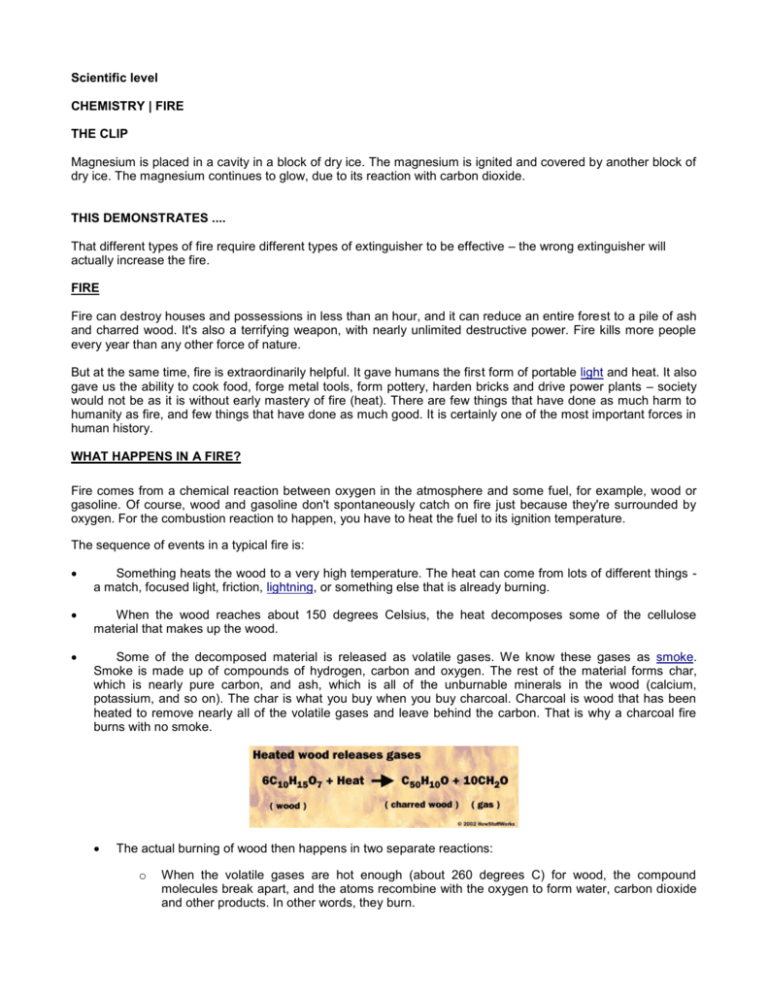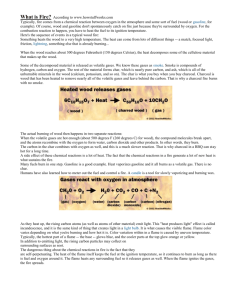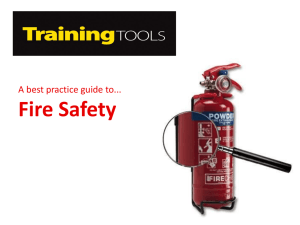Scientific level CHEMISTRY | FIRE THE CLIP Magnesium is placed
advertisement

Scientific level CHEMISTRY | FIRE THE CLIP Magnesium is placed in a cavity in a block of dry ice. The magnesium is ignited and covered by another block of dry ice. The magnesium continues to glow, due to its reaction with carbon dioxide. THIS DEMONSTRATES .... That different types of fire require different types of extinguisher to be effective – the wrong extinguisher will actually increase the fire. FIRE Fire can destroy houses and possessions in less than an hour, and it can reduce an entire forest to a pile of ash and charred wood. It's also a terrifying weapon, with nearly unlimited destructive power. Fire kills more people every year than any other force of nature. But at the same time, fire is extraordinarily helpful. It gave humans the first form of portable light and heat. It also gave us the ability to cook food, forge metal tools, form pottery, harden bricks and drive power plants – society would not be as it is without early mastery of fire (heat). There are few things that have done as much harm to humanity as fire, and few things that have done as much good. It is certainly one of the most important forces in human history. WHAT HAPPENS IN A FIRE? Fire comes from a chemical reaction between oxygen in the atmosphere and some fuel, for example, wood or gasoline. Of course, wood and gasoline don't spontaneously catch on fire just because they're surrounded by oxygen. For the combustion reaction to happen, you have to heat the fuel to its ignition temperature. The sequence of events in a typical fire is: Something heats the wood to a very high temperature. The heat can come from lots of different things a match, focused light, friction, lightning, or something else that is already burning. When the wood reaches about 150 degrees Celsius, the heat decomposes some of the cellulose material that makes up the wood. Some of the decomposed material is released as volatile gases. We know these gases as smoke. Smoke is made up of compounds of hydrogen, carbon and oxygen. The rest of the material forms char, which is nearly pure carbon, and ash, which is all of the unburnable minerals in the wood (calcium, potassium, and so on). The char is what you buy when you buy charcoal. Charcoal is wood that has been heated to remove nearly all of the volatile gases and leave behind the carbon. That is why a charcoal fire burns with no smoke. The actual burning of wood then happens in two separate reactions: o When the volatile gases are hot enough (about 260 degrees C) for wood, the compound molecules break apart, and the atoms recombine with the oxygen to form water, carbon dioxide and other products. In other words, they burn. o The carbon in the char combines with oxygen as well, and this is a much slower reaction. A side effect of these chemical reactions is a lot of heat. The fact that the chemical reactions in a fire generate a lot of new heat is what sustains the fire. Many fuels burn in one step. Gasoline is a good example. Heat vaporizes gasoline and it all burns as a volatile gas and no char is formed. Humans have also learned how to meter out the fuel and control a fire. A candle is a tool for slowly vaporizing and burning wax. As they heat up, the rising carbon atoms (as well as atoms of other material) emit light. This "heat produces light" effect is called incandescence, and it is the same kind of thing that creates light in a light bulb. It is what causes the visible flame. Flame color varies depending on what you're burning and how hot it is. Color variation within a flame is caused by uneven temperature. Typically, the hottest part of a flame -the base -- glows blue, and the cooler parts at the top glow orange or yellow. In addition to emitting light, the rising carbon particles may collect on surrounding surfaces as soot. The dangerous thing about the chemical reactions in fire is the fact that they are self-perpetuating. The heat of the flame itself keeps the fuel at the ignition temperature, so it continues to burn as long as there is fuel and oxygen around it. The flame heats any surrounding fuel so it releases gases as well. When the flame ignites the gases, the fire spreads. THE FIRE TRIANGLE As stated above, three things must be present at the same time in order to produce fire: 1. Enough oxygen to sustain combustion, 2. Enough heat to raise the material to its ignition temperature, 3. Some sort of fuel or combustible material. Oxygen, heat, and fuel are frequently referred to as the "fire triangle”. If any of these three things is removed or reduced to a point where the triangle is unstable, the fire is extinguished. Essentially, fire extinguishers put out fire by taking away one or more elements of the fire triangle. Fire safety, at its most basic, is based upon the principle of keeping fuel sources and ignition sources separate. THE CLASSIFICATION OF FUELS Not all fires are the same, and they are classified according to the type of fuel that is burning. If the wrong type of fire extinguisher is used, on the wrong class of fire, the fire can become worse. The four different fire classifications are: 1. Class A – Solid combustibles that are not metals, such as, wood, paper, cloth, trash and plastics. 2. Class B – Any non metal in a liquid state, on fire. This classification also includes flammable gases such as gasoline, oil, grease and acetone. 3. Class C – Electrical, that is, energized electrical equipment. 4. Class D – Metals, such as, potassium, sodium, aluminium and magnesium. These are mostly found in industry and in laboratories. It takes special extinguishing agents, ex. Metal-X and foam, to fight such a fire. Most fire extinguishers will have a pictograph label showing which classifications of fire the extinguisher is designed to fight. For example, a simple water extinguisher might have a label like the one below, indicating that it should only be used on Class A fires. TYPES OF FIRE EXTINGUISHERS Different types of fire extinguishers are designed to fight different classes of fire. The three most common types of fire extinguishers are: water (designed for Class A fires), carbon dioxide (designed for Class B and C fires), dry chemical (designed for Class B and C fires). Water extinguishers cannot be used to extinguish flammable liquid fires as it would just spread such a fire further. Nor should they be used to extinguish electrical fires, as this would lead to electrocution, due to the water being an extremely good conductor of electricity. Carbon dioxide extinguishers contain carbon dioxide which is a non flammable gas that extinguishes fire by displacing oxygen, or by taking away the oxygen element. Carbon dioxide becomes very cold as it comes out of the extinguisher and therefore it cools the fuel as well. CO2s may be ineffective at extinguishing Class A fires because they may not be able to displace enough oxygen for long enough to successfully put the fire out. Class A materials may also smolder and re-ignite. Dry Chemical extinguishers put out fire by coating the fuel with a thin layer of dust, separating the fuel from the oxygen in the air. The powder also works to interrupt the chemical reaction of fire, so these extinguishers are extremely effective at putting out fire. It is obviously of the utmost importance that before trying to extinguish a fire, one must make sure that the fire extinguisher used is the one that should be used with that particular fire. ___________________________________________________________________ References: How Stuff Works [Online], http://www.howstuffworks.com/, 2 Mar, 2006. Classification of Fuels [Online], http://www.pp.okstate.edu/, 2 Mar 2006.




